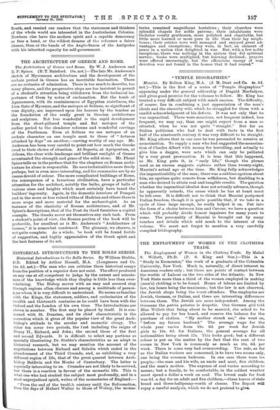THE ARCHITECTURE OF GREECE AND ROME.
The Architecture of Greece and Rome. By W. J. Anderson and IL P. Spiers. (B. T. Batsford. 18s. net.)—The late Mr. Anderson's sketch of Mycenaean architecture and the development of the archaic period in Greece has an inevitable fascination. There are no ecstasies of admiration. There is too much to describe, too many phases, and the progressive steps are too insistent to permit of a student's attention being withdrawn from the technical im- portance of them by notes of exclamation. But the tomb of Agamemnon, with its reminiscences of Egyptian stateliness, the Lion Gate of Mycenae, and the metopes at Selinus, so significant of true dignity, are impressed upon his hearers by the teacher as the foundation of the really great in Grecian architecture and sculpture. Not less wonderful is the rapid development from the short-pillared temple and flat metopes of the earlier period to the slenderer columns and wonderful carvings of the Parthenon. Even at Selinus we see metopes of an archaic character on one temple next to those of "Actaeon attacked by dogs" on another,—carving worthy of any age. Mr. Anderson has been very careful to point out how much the Greeks owed to their choice of situation. At Segesta, at Agrigentum, at Athens, the clear wide landscape and brilliant sunlight of Greece accentuated the strength and grace of the solid stone. Mr. Phone Spiers tells us in the preface that for the chapters on Roman archi- tecture he alone is responsible. He uses technicalities more freely perhaps, but is even more interesting, and his summaries are by no means devoid of colour. The more complicated buildings of Rome, the consequence of a luxurious civilisation, have a particular attraction for the architect, notably the baths, groups of halls of various sizes and heights which must certainly have taxed the builders' ingenuity. Again, in the domestic interiors of Pompeii and in the more or less ruined villas of Hadrian and others there is snore scope and more material for the archaeologist. As an Instance of the elasticity of Roman architecture, and of Mr. Spiers's descriptions, that of the Pont du Gard furnishes a capital example. The Greeks never set themselves any such task. From a student's point of view, the Roman portion of the book will be preferable, for excellent as is Mr. Anderson's "Architecture of Greece," it is somewhat condensed. The glossary, we observe, is not quite complete. As a whole, ' he book will be found fertile of suggestion, and highly appreciative of the Greek spirit and the best features of its art.






















































 Previous page
Previous page